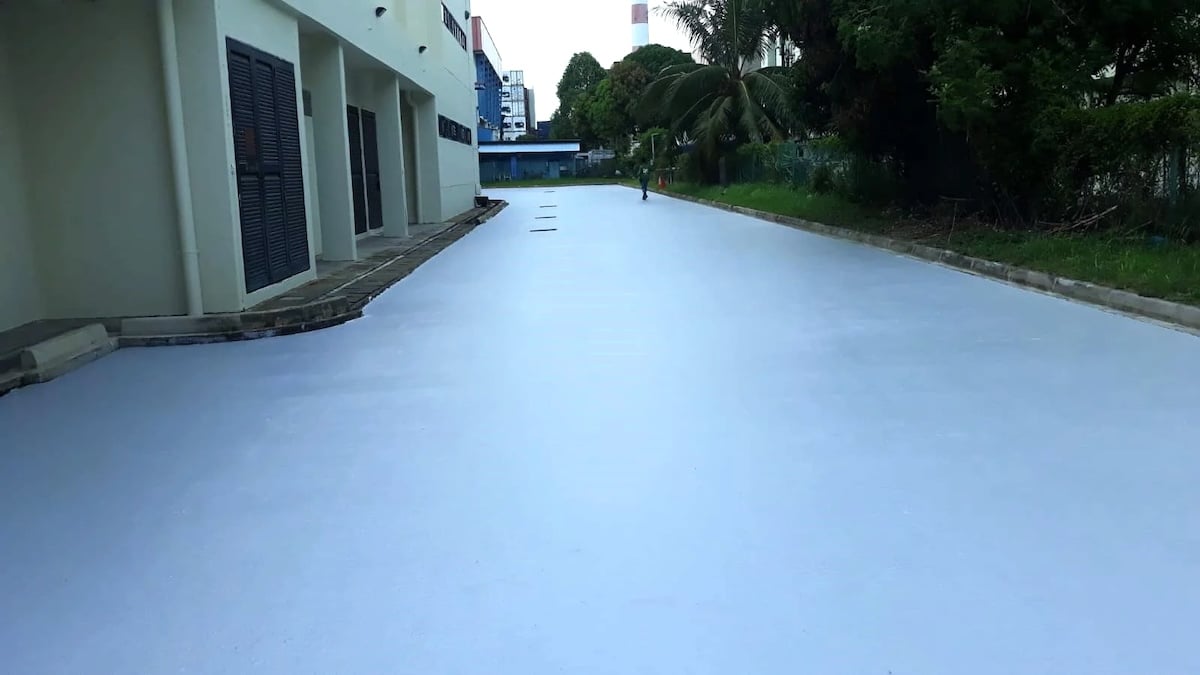Ecowatch
Specialized Paint Coatings Help Cities Feel as Much as 1.5°C Cooler, Study Finds

The road pavement of the test site in Singapore with cool paint coatings. Nanyang Technological University

Why you can trust us
Founded in 2005 as an Ohio-based environmental newspaper, EcoWatch is a digital platform dedicated to publishing quality, science-based content on environmental issues, causes, and solutions.
A new study by researchers at Nanyang Technological University (NTU Singapore) has demonstrated that the use of particular paint coatings in urban settings can help city dwellers feel as much as 1.5 degrees Celsius cooler, creating a more livable environment.
Additives in cool paint coatings reflect the sun, reducing the absorption and emission of surface heat, a press release from NTU Singapore said. They are a method of combating the “urban heat island (UHI) effect” — when cities get warmer than the areas that surround them.
“Our study provides evidence that cool paint coatings reduce heat build-up and contribute to the cooling of the urban environment,” said lead author of the study Dr. E V S Kiran Kumar Donthu, a former research fellow at NTU’s Energy Research Institute, in the press release. “This is a minimally intrusive solution for urban cooling that has an immediate effect, compared to other options that often require major urban redevelopment to deploy. Moreover, by reducing the amount of heat absorbed in urban structures, we also reduce heat load in buildings, consequently reducing indoor air-conditioning energy consumption.”
Most previous research into cool paint coatings used scaled-down models or was based on simulations, rather than being conducted in the real world.
The NTU study was conducted in an industrial part of Singapore and looked at how well the coatings worked against the heat of the city.
The research team coated road pavements, roofs and walls with cool paint coatings and discovered that — compared with an adjacent environment that had not been coated — the coated area was as much as two degrees Celsius cooler in afternoon heat. The team used the Universal Thermal Climate Index and found that the thermal comfort level of pedestrians was up to 1.5 degrees Celsius better.
“Findings from the study are not just relevant for cities in Singapore where it is hot all year round, but for other urban areas around the world too. With global warming, people will increasingly look for ways to stay cool. Our study validates how cool paint coatings can be a strategy to reduce the urban heat island effect in future,” said Wan Man Pun, the study’s lead investigator and an associate professor at NTU’s School of Mechanical & Aerospace Engineering (MAE), in the press release.
The study, “Dynamics of cool surface performance on urban microclimate: A full-scale experimental study in Singapore,” was published in the journal Sustainable Cities and Society.
For the study, the team chose four rectangular buildings that formed a pair of parallel “street canyons” in a west Singapore industrial estate managed by JTC Corporation.
One of the canyons — the “cool canyon” — had cool paints coating the pavement, walls and roofs, while the “conventional canyon” acted as the control, with no paint being applied.
“Using environmental sensors, the NTU team monitored the conditions in the two canyons over two months, which included air movement, surface and air temperature, humidity, and radiation, to see how well the cool paint coatings worked in reducing city heat,” the press release said.
Over a period of 24 hours, the researchers discovered that the cool canyon released 30 percent less heat from its built-up surfaces, making its air temperature as much as two degrees Celsius cooler than the conventional control canyon at around 4 p.m. — the hottest time of day. This resulted in cool canyon pedestrians feeling up to 1.5 degrees Celsius cooler.
The team also discovered that the cool canyon’s air temperature was lower due to less heat being absorbed and stored in roads, walls and roofs, which would have been otherwise released, leading to hotter temperatures in the interior of the building or the surrounding air.
In comparison with conventional roofs, cool paint-coated roofs absorbed as much as 40 percent less heat and reflected 50 percent more sunlight during the hottest period on a sunny day. Additionally, most of the heat was prevented from entering the buildings because of the coated walls.
“Our study showed that cool paint coating on the road significantly helped lower the hottest temperatures in the cool canyon, confirming that cool paint coating can be a promising way to make urban areas cooler and more comfortable, especially during hot weather. We hope findings from our study will encourage more urban planners to adopt cool paint coatings on more built-up surfaces, on a large scale,” said Ng Bing Feng, co-author of the study and an assistant professor at NTU’s School of MAE, in the press release.
Subscribe to get exclusive updates in our daily newsletter!
By signing up, you agree to the Terms of Use and Privacy Policy & to receive electronic communications from EcoWatch Media Group, which may include marketing promotions, advertisements and sponsored content.
Source
Disclaimer: No copyright infringement intended. All rights and credits reserved to respective owner(s).











